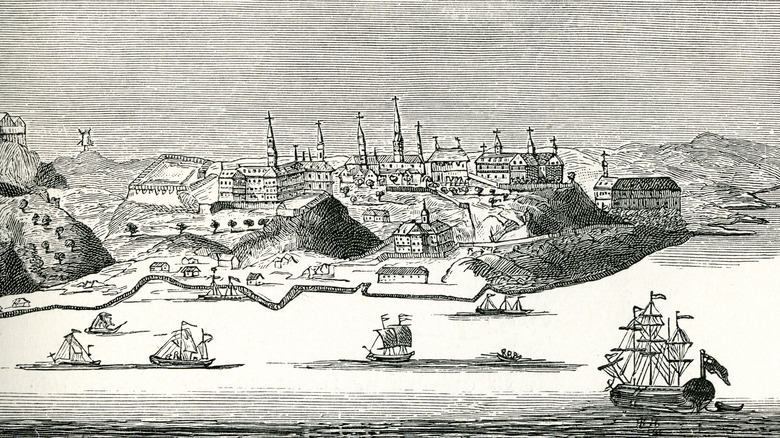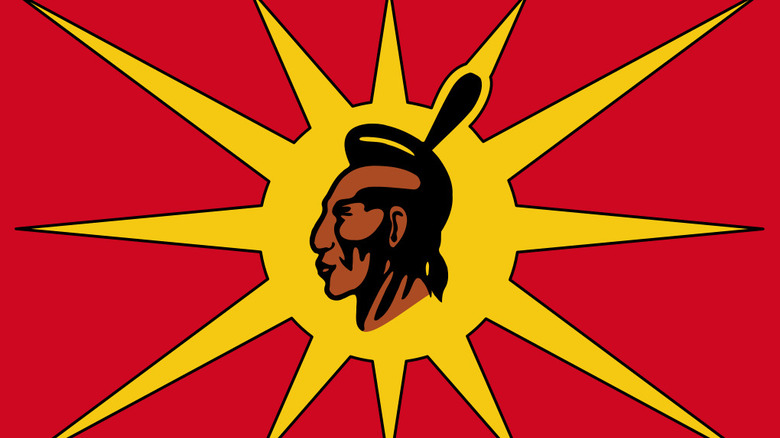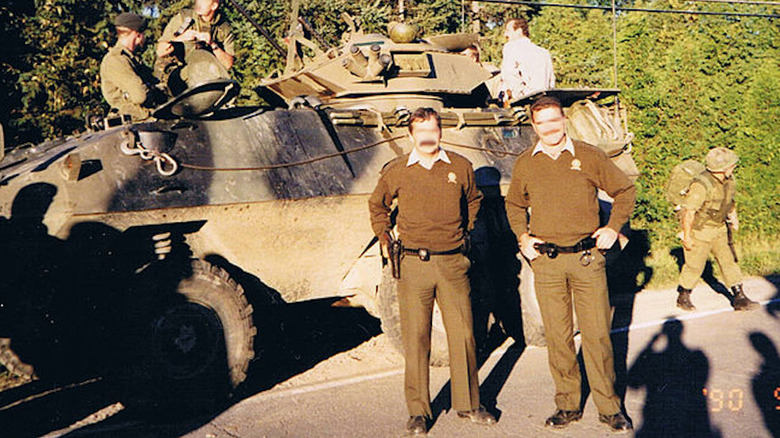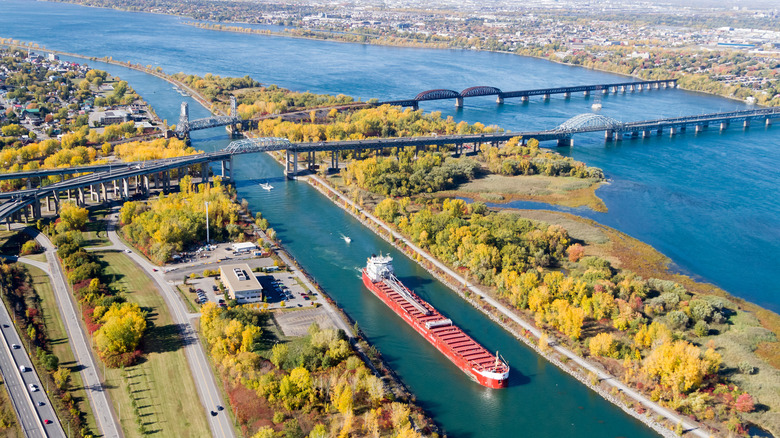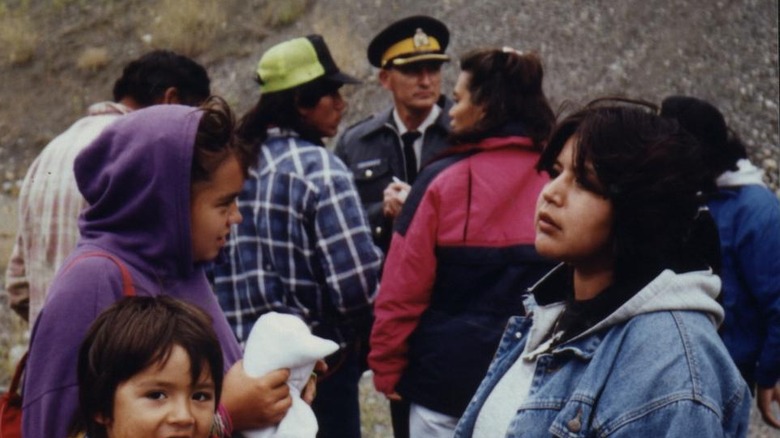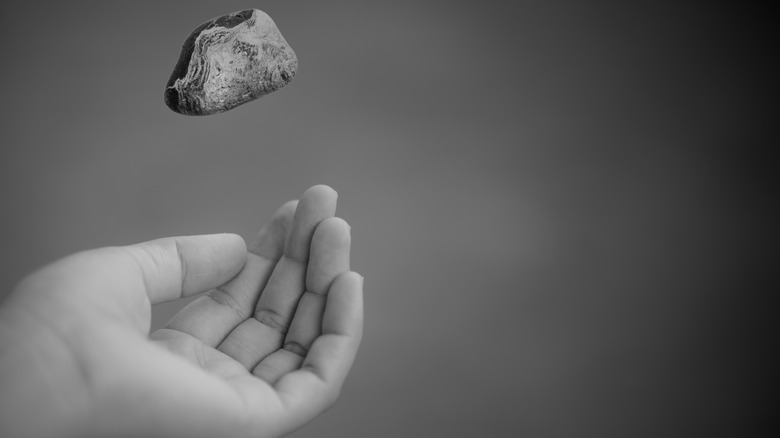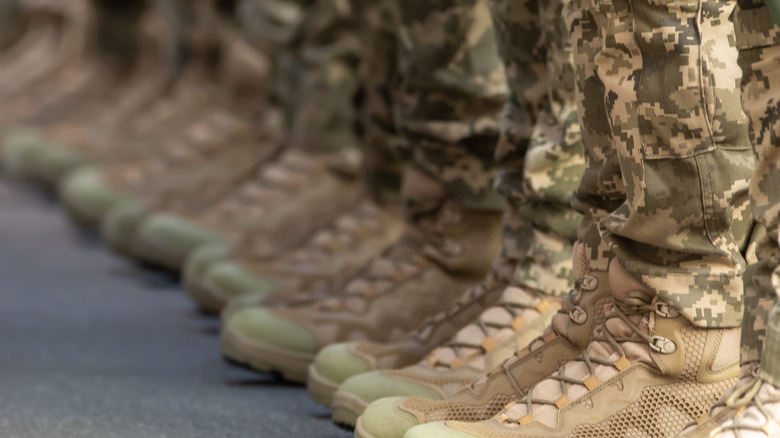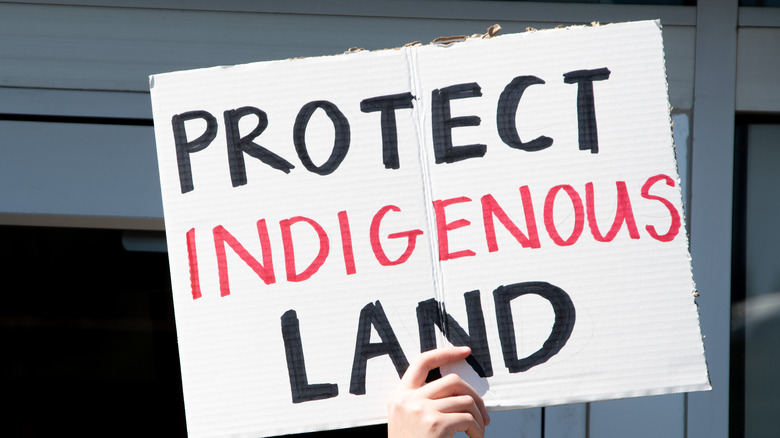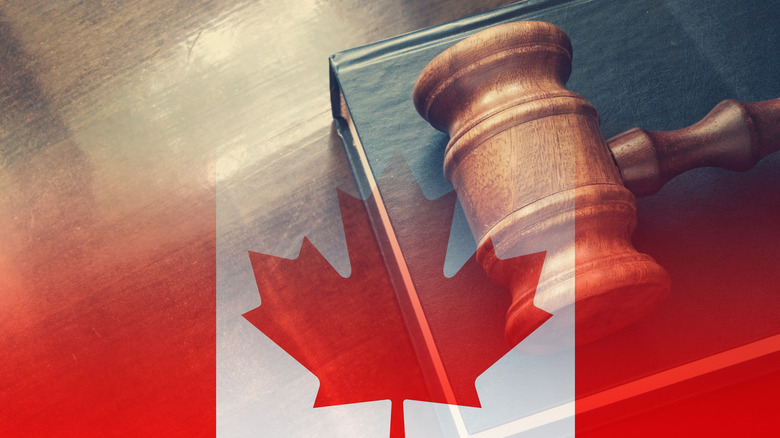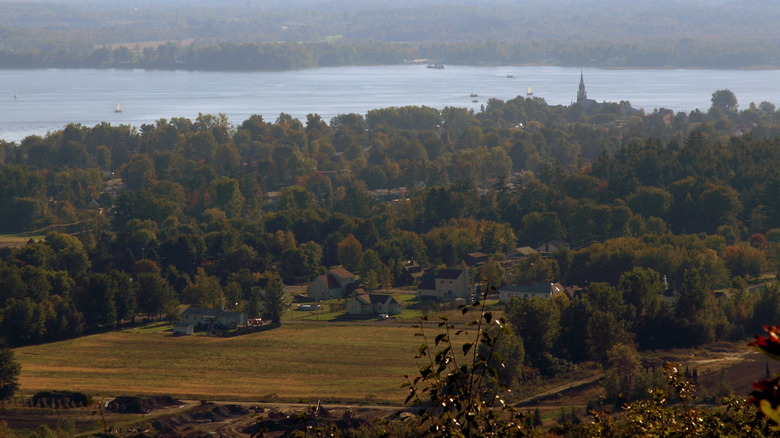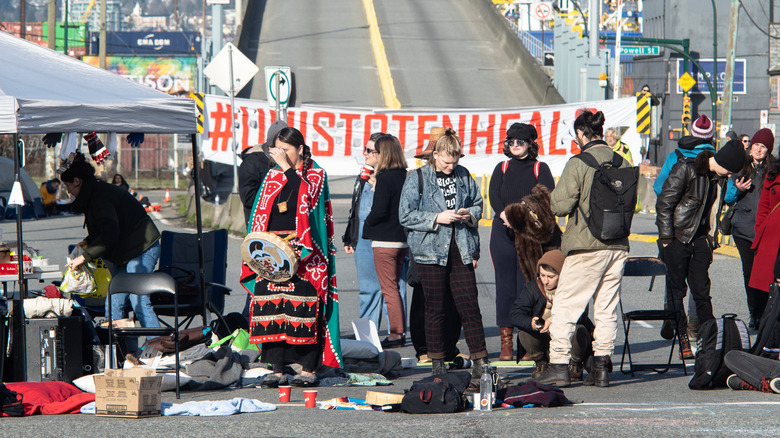What Really Happened During The Violent Canadian Oka Crisis Of 1990
Over the course of a 78-day armed standoff, the Kanien'kehà:ka (or Mohawk) people of a small village named Kanehsatà:ke (or Oka) outside of Montreal, Canada, fought for their right to their land. At times, the confrontations became violent as both state and civilian forces sought to suppress the resistance, according to the Harvard International Review.
The Kanehsatà:ke resistance, also known as the Oka Crisis, involved a golf course expansion that would've desecrated a Mohawk burial ground and forest of pine trees. But the land disputes involving the Mohawk and the golf course can be traced back to the colonization of North America, exemplifying how some of the earliest colonial practices have long-lasting repercussions that have yet to be addressed and rectified.
The Kanehsatà:ke resistance can be described as a success since the golf course expansion was halted as a direct result of the protest movement. But ultimately, few of the issues underlined by the Mohawk people were actually remedied in the aftermath of the resistance. Here's what really happened during the violent Oka Crisis of 1990.
The first land disputes
There have been land disputes in the Canadian province of Quebec from the moment that First Nation lands were colonized in Canada in the 1700s. Interculture Journal writes that one of the earliest land claims from Mohawk leaders came in colonial times, in 1781, after 66 of the best pieces of land were given to white settlers. But unfortunately, this claim was repeatedly rejected and Mohawk people were told that they didn't have a valid title to their land.
Over the next 200 years, land claims brought up by the Mohawk people were repeatedly rejected. In 1977, the land claims by the Mohawk people even went on to lose in federal court. In most instances, the land was owned by The Priests of the Seminary of St. Sulpice, who would also transfer land lots to the municipality of Oka without consulting the Mohawk people, per the Department of Indian and Northern Affairs.
In 1960, the Mohawk people discovered that the town of Oka intended to lease part of the land that had been taken from them to a private golf course. Despite writing to the Indian Affairs Branch of the federal government and appearing before the Joint Committee on Indian Affairs, they were unable to keep the golf course from being built. As noted in "Canadian Colonialism," the land that the golf course was built on included a Mohawk burial ground.
The golf course expansion
In March 1989, the Mayor of Oka, Jean Ouelette, revealed plans to expand the golf course built in the 1960s. "The Colonial Problem," notes that the expansion involved turning the nine-hole course into an 18-hole course, in addition to building 60 luxury townhouses. At the time, the burial ground, known as the Pine Hill Cemetery, had been squeezed in between the golf club's driveway and its parking lot, per "Environmental Justice and the Rights of Indigenous Peoples." This expansion would have resulted in the destruction of the pine groves and Pine Hill Cemetery.
Ouellette didn't bother consulting the Mohawk people of the nearby Kanehsatà:ke community about the expansion since the government had historically repeatedly denied Mohawk land claims. When asked about the lack of consultation during a municipal council meeting, she responded by shrugging and saying, "You know you can't talk to the Indians."
According to "Police Powers in Canada," because the land wasn't technically owned by the Mohawk people, they had little legal recourse against the expansion onto their land, having also had their land claims rejected in 1975 and 1977. Despite this, there was still an attempt by the Mohawk people to halt the desecration through the court system. Unfortunately, History Collection writes that in 1990, a court ruled in favor of the golf course expansion.
Protesting the court decision
In response to the court decision that rejected the land claims of the Mohawk people, residents of Kanehsatà:ke created a barricade on the path leading to the burial ground as a protest on March 10, 1990. Meant to prevent any development towards the expansion, more and more members of the Kanehsatà:ke community soon joined the protest. Even those that didn't join the camp would spend time there after work or school.
Westra writes in "Environmental Justice and the Rights of Indigenous Peoples" that signs were also put up near the edge of the golf course that read, "Are you aware that this is Mohawk land," in French and English. After Earth Day in April 1990, members of the Mohawk Warriors Society also joined the camp and set up cement blocks in addition to using a fallen log to block another entrance to the burial ground.
Negotiations began, but there was little change in the situation. According to Le Devoir, the municipality of Oka got a court injunction ordering the Mohawk activists to remove the barricade in June of that year, but they refused and maintained the positions by the burial ground. Around this time, the Mohawk protestors also started arming themselves for protection.
Deploying the police to the Oka Crisis
On July 11, 1990, Mayor Ouellette called in up to 1,000 members of the provincial police of Québec, the Sûreté du Québec (SQ) — equipped with shields, helmets, revolvers, and sticks — to break up the Kanehsatà:ke resistance. According to "The Colonial Problem," there were tactical intervention teams, riot police, and command and emergency units.
According to the Montreal Gazette, the SQ managed to drive the Mohawk protesters away from the barricade with tear gas and concussion grenades by 8:30 a.m. As police tried to move the dirt mounts and cement blocks, gunfire started — although accounts vary greatly as to who fired the first shot. Regardless, Corporal Marcel Lemay was shot and killed. It's unknown whether the bullet that hit and killed Lemay was from the protestors or his fellow officers. The SQ retreated after Lemay was shot, and the Mohawk protestors used the abandoned cars for additional fortification. According to the Global Nonviolent Action Database, this time the barricade also blocked Highway 344.
Solidarity blockade at Mercier Bridge
As part of a solidarity protest, the Mohawk people of Kahnawá:ke also constructed a blockade on the Honoré Mercier Bridge. According to Harvard International Review, Mercier Bridge was one of the four main bridges that connected the island of Montreal to the residential areas on the south shore. As a result, the blockade was incredibly effective in disrupting traffic. In response to the blockade on Mercier Bridge, white Montreal residents started having their own protests calling for police forces to stop the Mohawk people — full of racist activity like burning effigies of Mohawk people and racist chants, according to "National Identity and the Conflict at Oka."
"Freedom and Indigenous Constitutionalism" notes that at the peak of the resistance, Highways 132, 138, and 207 were all also blockaded, leading to huge traffic jams and their ensuing road rage. The blockade on Mercier Bridge subsequently stayed up for another two months, writes Indian Country Today. Meanwhile, SQ was busy preparing their own barricades, per "The Colonial Problem."
Building the resistance
Thousands of Indigenous allies soon joined the Kanehsatà:ke resistance with acts of solidarity. As per "In Defense of Mohawk Land," although the first acts of support were spontaneous responses, before long they organized, effectively cutting off supplies and transportation routes for many Canadian provinces. Ojibway people from the Long Lake reserve sealed off part of the Trans-Canadian Highway and the Canadian railway. An island on the Ottawa river was occupied by Algonquin people from western Quebec. And St'latl'imx people from the Seton Lake reserve made blockades among seven roads and railway lines that passed through their reserve.
Many Indigenous people from the United States and Canada also traveled to Oka to physically join the resistance, like Nancy Wonshon, a Chippewa woman from Detroit. Wonshon was able to join the Mohawk people behind the barricades, stating that "Oka was a reminder to what has happened to all of us and an opportunity to act against it. It symbolized something we all believe in — the struggle to defend our land and our rights."
The Oka Crisis escalates
As the Mohawk resistance continued, there were a number of violent interactions between non-Indigenous Canadians and the First Peoples. According to "The Colonial Problem," residents frequently gathered to yell assaults and throw rocks, bottles, and Molotov cocktails. During the violent assault on the Mohawk protestors in which some 500 non-Indigenous residents gathered, Mohawk elder Joe Armstrong was struck in the chest with a stone and died of heart failure one week later, per "Settler." Another Mohawk elder was poisoned by tear gas and also later died.
During another incident, a woman tried to leave the Mohawk community behind the barricades because she started to hemorrhage after childbirth. But as she was transported to a hospital, a white mob surrounded her ambulance and forced her to "spread her legs" and prove that she'd actually delivered her child, per "The Colonial Problem." Meanwhile, the police officers that were there did nothing to stop the assault.
Overall, between July and September, hundreds were injured, including the Mohawk people, non-Indigenous residents, and SQ officers. Mohawk activist Katsi'tsakwas Ellen Gabriel, who participated in the resistance, writes in Ricochet that the state violence also led to post-traumatic stress.
Calling in the troops
After the standoff between the SQ and the Kanehsatà:ke resistance began in the summer of 1990, the Royal Canadian Mountain Police were also called in. But according to "Ipperwash," it wasn't long before Quebec Premier Robert Bourassa invoked the National Defence Act in order to also send federal troops in, comparing the situation to the kidnapping, murder, and unrest of Quebec's 1970 October Crisis. The SQ and the RCMP were joined by at least 2,500 Canadian military forces that August, per "The Inconvenient Indian."
"The Colonial Problem" notes that the rebellion would end up costing the Canadian government a total of $150 million, although "Ipperwash," suggests the total price may have been as high as $200 million. According to the Journal of Military and Strategic Studies, the armed forces were ordered to not stir up too much trouble in order to allow any negotiations made to potentially succeed, but there were reports of them blocking the resupply of food and medical supplies to the Mohawk people. They also didn't permit reentrance if any of the Indigenous protesters left to meet with a lawyer. Although the military managed to negotiate with the Kahnawà:ke and end the blockade on the Mercier bridge, the Kanehsatà:ke resistance was unwilling to concede without the complete assurance that the golf course expansion would be canceled.
The Oka Crisis ends
Negotiations with the Mohawk protestors on the Mercier Bridge led to the blockade being dismantled on August 29, 1990. Once there were no more traffic jams, the Quebec government put a pause on negotiations, according to "Ipperwash." On September 25, Prime Minister Brian Mulroney announced that there would be new federal initiatives with regard to the Indian Act when it came down to land claims and self-government, per the Journal of Military and Strategic Studies.
The following day, the soldiers told the people of Oka to evacuate and Harvard Business Review writes that many Mohawk people of Kanehsatà:ke took shelter in Montreal, fearing for their lives. As they fled, white mobs pelted them with rocks. As some of the Mohawk protestors try to leave, the exodus turns chaotic and violent. A 14-year-old Mohawk protestor named Waneek Horn Miller was struck with a non-lethal blow from a bayonet. Eleven weeks later after it started, the resistance dispersed, and The New York Times reports that those who participated were forced onto school buses and taken in for questioning. As The Conversation notes, the protest movement basically wound up in a stalemate. Although the violence stopped, the "disputed land was not returned to the Mohawks."
Many charged and convicted in the Oka Crisis
After 78 days of an armed standoff, the Kanehsatà:ke resistance was declared to be over, and police forces took in about 50 people for questioning, reports RCI. Several were subsequently charged for their part in the resistance. The Los Angeles Times reports that some, like Ronald Cross and Gordon Lazore, were found guilty of several charges including arms possession.
One case, involving 37 Mohawk people and their supporters, became the largest trial in Canadian history to date, according to Cultural Survival. With a total of 88 charges for things like riot participation to possessing firearms, all of them were subsequently acquitted of all charges by a Quebec Superior Court jury, per AMMSA. According to The Research Branch of the Library of Parliament, 32 Mohawk people were convicted in the aftermath of the Kanehsatà:ke resistance in the end with charges like "obstructing police officers, assault, participating in a riot and possession of a weapon for a purpose dangerous to the public peace."
Canceling the expansion
Despite the fact that the resistance was disbanded and that the ownership of the land merely moved from the provincial government to the federal government, the Kanehsatà:ke resistance did succeed in canceling the golf course expansion. "The Failure of Nonviolence," argues the movement was also a success because it occupied space and served as a strong example of Indigenous sovereignty. Unfortunately, many may not see the resistance in such a positive light, as over the course of the 78 days of armed resistance, at least two Mohawk elders died as a result of injuries sustained from the mob or police assaults, hundreds of Mohawk civilians were injured, and one SQ officer was killed, per Harvard Business Review.
The 1993 Country Reports on Human Rights Practices notes that because the land claims issue wasn't fully addressed, confrontations between Mohawk activists and police continued in 1991 and 1992. And according to "The Colonial Problem," although the federal government did purchase some land to create and contiguous land base for the Kanehsatà:ke community, The Montreal Gazette reports that "25 years later, the town of Oka still owns most of the forest at the heart of the standoff." However, the situation has progressed in various ways. As per "Ipperwash," in June 2000, the federal government signed an agreement with the Mohawk people that gave legal jurisdiction of over 960 hectares of land back to the Mohawk people.
The legacy of the Oka Crisis
The legacy of the Kanehsatà:ke resistance can be felt well into the 21st century. In 2018, as Wet'suwet'en people protested the construction of a natural gas pipeline that was to pass through their traditional territory in British Columbia, Harvard Business Review writes that blockades were constructed around Canada on roads and railway lines, impeding traffic and the transport of good similar to the actions of the Kanehsatà:ke resistance. High Country News also reports that the Kanehsatà:ke resistance led to a change in how police use force against protestors — namely with more weapons.
Unfortunately, little has changed in terms of settler reception of Indigenous issues. Like the protestors of the Kanehsatà:ke resistance, First Nations protestors in Canada continue to be the recipients of hate speech and threats of violence whenever they engage in protest movements. It's also alleged that police forces were instructed to use lethal force when removing protestors from Wet'suwet'en territory.

